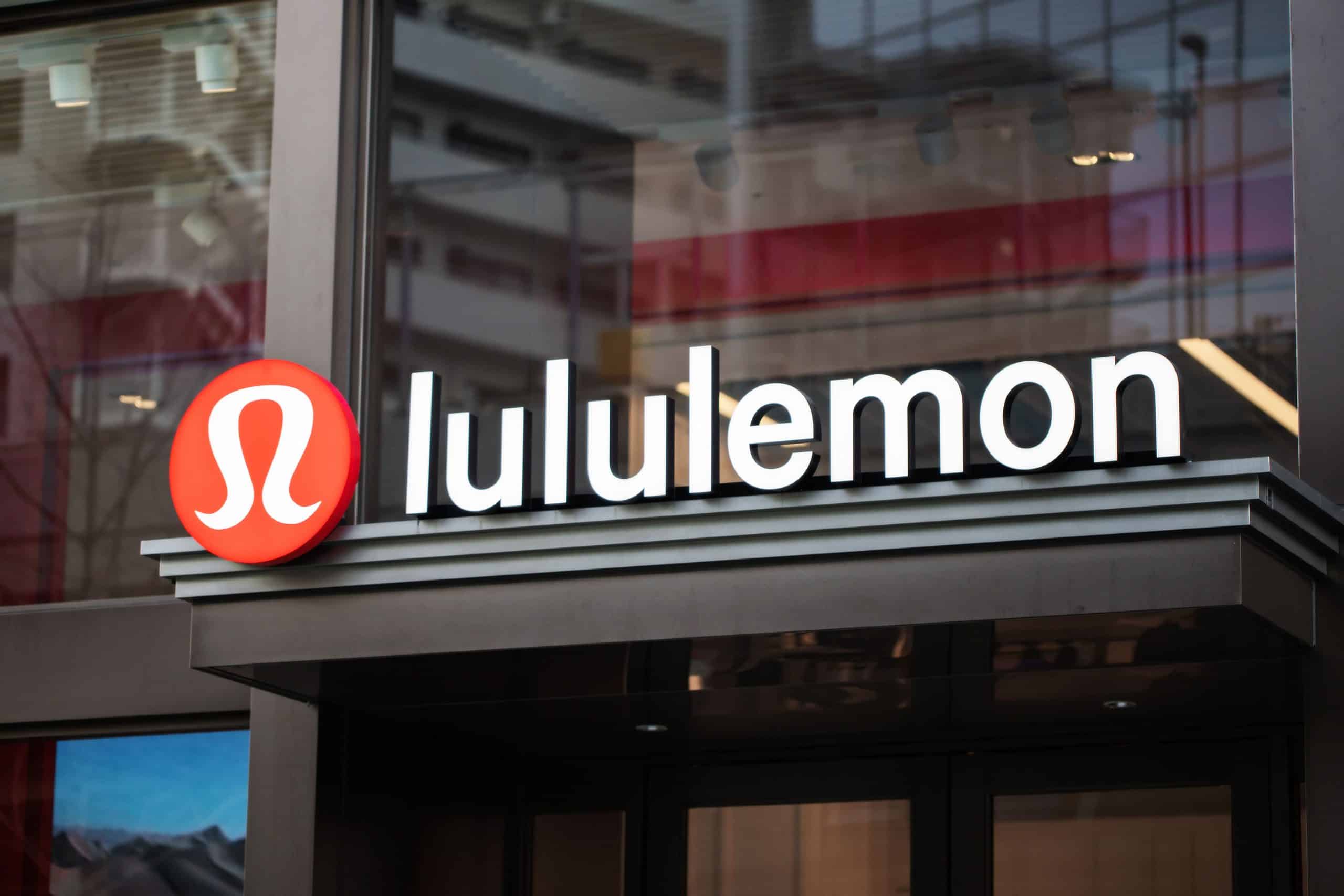Founded in 1998 in Canada, Lululemon has grown into a multibillion-dollar athletic apparel giant in less than three decades based on smart business decisions and knowing its audience. As of November 2024, Lululemon’s net worth was $39.06 billion.
Our experts at Business2Community have organized the key information about Lululemon’s net worth and history to help you understand how the company reached its position. Here, you’ll find insights into how the industry innovator consolidated its leading position in a competitive business landscape.
Lululemon Key Data
Lululemon Net Worth: $39.06 billion
Date Founded: 1998
Founded by: Chip Wilson
Current CEO: Calvin McDonald
Industries: Clothing
Lululemon Stock Ticker: NASDAQ: LULU
Dividend Yield: 0%
What is Lululemon’s Net Worth?
As of November 2024, Lululemon’s net worth or market cap was $39.06 billion. Its stock price was $318.13 with 124.7 million shares outstanding, after recovering from a severe drop earlier in the year due to the growing inflation rates and the decline of purchasing power in the US.
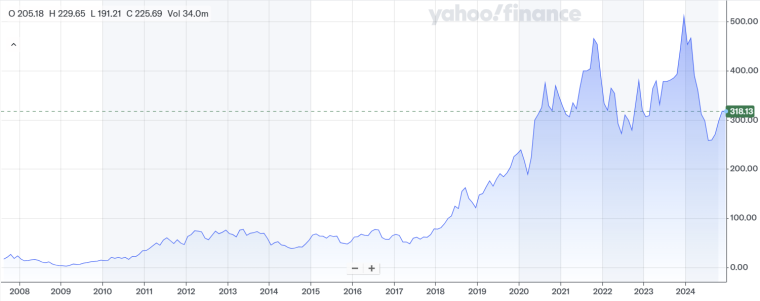
The company went public in July 2007 on the NASDAQ under the ticker symbol LULU, offering 18.2 million shares at $18, higher than the expected range of $10-12 per share. The IPO raised $327.6 million.
Shortly after Lululemon went public, the 2008 financial crisis hit the global economy. As a result, it lost 92% of its market value, plummeting from its pre-crisis level of $2.7 billion in October 2007 to $250 million by March 2009. It took the company 21 months to fully bounce back from the hit in terms of net worth.
Lululemon adapted quickly to the changes in the business environment by adjusting its product components and liquidity ratio, which we will cover in the next section. It hit its first $1 billion revenue in 2011. Since then, its revenue has been rising steadily.
In the first quarter of 2020, due to the global pandemic, Lululemon’s net worth experienced a stark drop, plummeting from $32 billion to $17 billion in a month between February and March, reflected in a stock price drop to $181 per share in May from $247 at the beginning of the year.
After that, it was able to pick up quickly and recovered in just 3 months through efficient strategies focusing on online shopping.
In January 2024, stock prices hit an all-time high of $508 after a strong holiday season. However, the second and third quarters were difficult for the women’s clothing retailer. With North America accounting for 80% of its total business, the drop in consumer purchasing power and the rising inflation rates in the US led to the downfall of its stock price, diving as low as $258 per share in August 2024.
It gradually climbed back up to $303 in October due to a positive second-quarter financial report that marked a 31% increase in international sales.
Lululemon’s financial year ends on December 31, and a full financial report is expected by the end of April next year. The company does not pay dividends. In its 2023 Annual Report, Lululemon stated that it didn’t plan on “paying any cash dividends on our common stock in the foreseeable future” due to its cash needs and expansion plans.
Lululemon Revenue
For the 2023 financial year, Lululemon’s revenue was $9.619 billion. Ever since the company went public, it has experienced a stable rise in revenue, even during various global crises.
During the 2008 financial crisis, Lululemon focused on cutting back inventory levels and producing popular styles to increase cash flows and reduce illiquid assets. This strategy turned out to be a massive success. The company was able to retain a much larger cash flow when other businesses struggled to turn their assets into cash.
Its high liquidity ratio allowed it to open new stores without debt financing, giving it a clear edge over its competitors. When other businesses were suffering greatly, Lululemon’s revenue increased by $100 million in 2009 to $450 million from its 2008 figures.
The leading fashion brand’s agility was tested once again when COVID-19 affected business transactions globally. This time, Lululemon was even quicker to adapt to the crisis. It shifted its focus online, enhancing online shopping experiences and boosting sales even when physical stores remained closed.
Its 2020 revenue still saw an increase, from $3.39 billion in 2019 to $4.4 billion, consolidating its position as an apparel retailer giant.
Aside from being proactive and responsive to crises, Lululemon also adapts to new trends to boost sales. It offers an affiliate program for influencers and bloggers to promote its products more effectively, fully harnessing the power of social media.
| Year | Revenue ($ Billions) |
| 2015 | 2.06 |
| 2016 | 2.34 |
| 2017 | 2.65 |
| 2018 | 3.29 |
| 2019 | 3.98 |
| 2020 | 4.4 |
| 2021 | 6.26 |
| 2022 | 8.11 |
| 2023 | 9.62 |
Who Owns Lululemon?
Lululemon Athletica Inc. is a publicly traded company owned by its shareholders. It debuted on the NASDAQ and TFX stock exchanges in 2007. The three largest institutional shareholders are:
- FMR, LLC – 15.21%
- Vanguard Group – 9.98%
- Blackrock – 7.77%
Lululemon was founded by Chip Wilson in 1998 in Vancouver, Canada. It started as a yoga-inspired design studio and a space haven for yoga classes. However, the brand’s strong community focus spurred its evolution into a technical athletic apparel company.

Attending a local yoga class sparked the inspiration for Wilson, offering a solution to the discomfort he had endured from years of participating in sports. Wilson’s initial funding for Lululemon was partly generated from the 1997 sale of his company Westbeach.
His early investment in Lululemon included purchasing two Japanese flat-lock sewing machines for $80,000.
In his 2021 book The Story of Lululemon, Chip Wilson said he was destined to innovate technical athletic gear:
No one understood athletics, shoes, sports psychology, sponsorship, and technical apparel like I did.
Chip Wilson pioneered the “athleisure” category. Researchers at the University of Tennessee have recognized Lululemon as an innovator in athletic apparel, offering high-quality, stylish athleisure products.
As of October 2024, founder Chip Wilson has a total net worth of $6.5 billion.
Growth and Development of Lululemon
Let’s trace the journey of the company through the years and see how the history of Lululemon developed through the 21st Century.
A History of Lululemon – Key Dates
- Lululemon was founded by Chip Wilson in 1998 in Vancouver, Canada.
- In November 2000, Wilson opened the first standalone Lululemon store.
- On July 27, 2007, Lululemon made its IPO offering at $18 per share.
- Lululemon achieved $1 billion in sales in 2011.
- In December 2023, Lululemon Athletica Inc was valued $62.22 billion.
1998-2004 – The Early Years of Lululemon Athletica
The original design meetings and focus groups were a critical part of the history of Lululemon and its success. The name, logo, and ideas for Lulu products were all determined by 10 focus groups of 10 women attending the Lululemon design and yoga studio.
In March 1999, the first Lululemon Athletica store opened in Vancouver’s West Kitsilano neighborhood. The second-floor showroom catered to design meeting attendees and yoga class participants. Wilson spent less than $4,000 to set up the store, employing clever money-saving tactics like using wooden dowels as clothing racks.
In November 2000 Wilson opened the first standalone Lululemon store across the street. With just $20,000, he completed interior renovations and installed a standout mural featuring Wilson’s first yoga instructor, making the store truly unique.
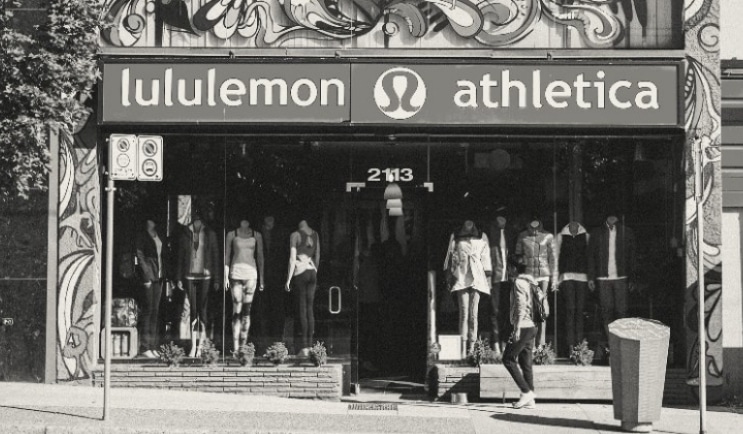
Lululemon began its franchising program in 2002. Franchising allowed the brand to accelerate growth and access new markets more efficiently. Franchise locations were opened in Toronto and Calgary.
The Vancouver-based company introduced its first US location in Santa Monica in 2003. As of January 2023, Lululemon was operating 350 stores in the US.
In 2004, Lululemon expanded globally with its first franchised store in Australia. Lululemon continued its global expansion and entered Japan with a franchise store in 2005.
The Desire to Create The Perfect Yoga Pants
As per the founder’s mouth himself, Wilson wanted to create ideal athletic wear for women’s bodies to solve transparency issues, address camel-toe, and enhance fabric thickness to conceal imperfections.
If I could get a technical fabric that felt like cotton instead of plastic, then add properties to make it moisture-wicking and anti-stink, I could create the perfect pant. Nothing like this existed in the world… I wanted to move the side seams to the back to frame the bum and make the bum appear smaller.
According to Bloomberg, Wilson’s descriptions in “Little Black Stretchy Pants” design aimed to “make women’s butts look good”.
Amanda Dunsmoor was the first designer at Lululemon Athletica. The initial line had two pants, a pair of shorts, and three tops. Limited by fabric costs and dye-lot quantities, they offered just six designs, each in four or five sizes – all in a single color: black.
The Boogie Pant were the first Lululemon yoga pants. The black Lycra flare-fit pants reminded Wilson of the ’70s. In 2017, The Boogie Pant was featured during the “Items: Is Fashion Modern” exhibit at the MoMA in New York.
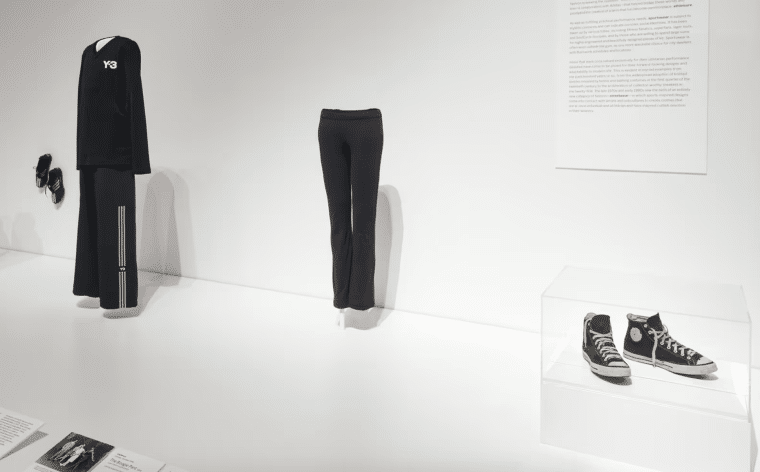
In the fall of 1999, “Power Women” Shannon Gray and Jackie Slater were hired to manage all aspects of Lululemon. Wilson took a job offer from Westbeach to redirect his salary back into Lululemon. As Chip Wilson himself said:
The company in its earliest days was run by smart, independent Super Girls, for smart, independent Super Girls.
Figuring Out How to Target The Female Market Segment
Founder Chip Wilson struggled with achieving economies of scale. The challenge came from selling 500 to 2,000 units swiftly – too much inventory limited the introduction of new clothing styles.
Lulemon products were showcased at the studio during yoga sessions. The shared space allowed attendees to discover the apparel during classes, fostering genuine word-of-mouth promotion.
Wilson created the “super girl” strategy which targeted women aged 22 to 42. It centered around the aspirational figure of the 32-year-old. This age represented career success, health, and freedom for younger women while evoking memories of a less demanding era for 40-year-old mothers.

Lululemon employees were originally in-store yoga instructors dubbed “educators”. They evolved into brand ambassadors and pivotal marketing assets. Chip Wilson believed by actively engaging them, seeking their input, and fostering discussions he was able to shape Lululemon’s designs.
2005-2010 – Lululemon’s Rapid Expansion
In 2005, Lululemon trademarked its original fabric, Luon. The unique fabric made from a high nylon microfiber composition formed the basis of their famous yoga pants.
Advent International’s investment of about CA$225 million in 2005 not only facilitated Lululemon’s global expansion but also played a role in initiating the hiring process for the company’s board members. Robert J. Meers became the first CEO of Lululemon Athletica Inc., leading the company until 2008. His tenure saw the initial stages of global development and the transition from franchising to joint ventures.
This robust expansion aligned with Lululemon’s impressive fiscal growth, with a net revenue increase from $40.7 million in fiscal year 2004 to $148.9 million in fiscal year 2006.
The IPO History of Lululemon
By July 1st, 2007, Lululemon had 59 stores in Canada and the US. The company confirmed plans to use IPO funds to open approximately 25 stores in 2007 and an additional 35 in 2008 across the US and Canada.
Before its IPO, Lululemon announced its distinctive community hub strategy to enhance the yoga brand and reinforce customer loyalty. By placing its stores in street locations, lifestyle centers, and malls, Lululemon Athletica strategically integrated each store as an essential community asset.
On July 27, 2007, Lululemon (LULU) made its initial public offering (IPO) offering shares at $18 each. On the day of its debut, lululemon stock opened at $25 per share and closed at $28.12 on the NASDAQ. Lululemon’s estimated IPO share price ranged between $15.00 and $17.00.
To commemorate its IPO, Lululemon hosted a large yoga event in Times Square, drawing numerous yoga enthusiasts and symbolizing their dedication to yoga and community engagement.

Christine Day became CEO of Lululemon Athletica after the IPO in January 2008. During the recession, Day emphasized innovation and technology to enhance the customer experience
The Journey to Brand Recognition
The company began printing manifestos on Lululemon shopping bags in 2008. This move made them one of the first companies to leverage reusable high-quality bags for brand recognition and sustainability.
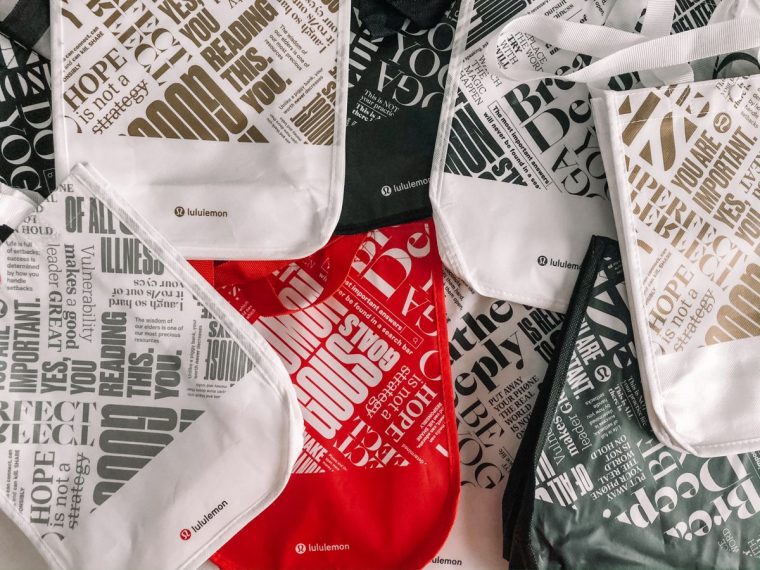
Furthermore, in April 2009, Lululemon expanded into ecommerce. By the holiday season of the same year, the Scuba Hoodie’s introduction through online channels made a substantial impact, contributing up to 20% of Lululemon’s Christmas sales.
As of December 2023, Lululemon offered international shipping services to a total of 78 countries.
2011 – 2019: Leadership Shifts & Product Growth
Founder Chip Wilson resigned from his role as Chief Innovation and Branding Officer at Lululemon in 2012. A year later, Lululemon’s board requested his return when a batch of their popular Luon pants were found to be too sheer. The faulty pants led to a 17% product recall, costing Lululemon $67 million in sales.
Christine Day stepped down as CEO in 2013, and Laurent Potdevin succeeded her in January 2014. However, Potdevin’s tenure ended abruptly in 2014 due to an inappropriate relationship with a female designer at the company.
Additionally, in 2014, Chip Wilson sold half of his 28% stake to Advent International for $845 million. He retained 40.2 million shares of Lululemon stock, representing 27.7 % of the company’s shares.
In 2015, Lululemon founder Chip Wilson stepped down from the board of directors. Despite not holding a management position at Lululemon, he maintains the largest individual ownership in the company, possessing an 8% stake.
Business Insider suggested that Chip Wilson’s resignation was influenced by the controversy surrounding his remarks. For example in his book Little Black Stretchy Pants, Wilson wrote that he is not necessarily opposed to child labor.

Since August 2018, Calvin McDonald has led Lululemon as CEO. Under his leadership, the company has consistently achieved double-digit revenue growth and has fast-tracked efforts to ensure 100% of its products are made from sustainable materials by 2030.
Product Innovation & Market Reception
Lululemon reached $1 billion in sales in 2011, aligning with its 13th spot on Fortune’s Fast-Growing Companies list, driven by strategic expansions and innovations.
In 2015, the Vancouver-based company introduced Nulu, an incredibly soft, lightweight, and stretchy material, crucial in their famous Align pants. Many Lululemon fans say that the Align leggings are the best choice within the brand’s lineup, a trend that continued as of September 2023.
Lululemon’s 2015 debut of the ABC Pant for Men sparked media attention for its controversial abbreviation, “anti-ball crushing”, marking the brand’s entry into the men’s business line.

Additionally, in June 2019, Lululemon launched its personal care line. The Lululemon goods are designed for athletes, include four products that smoothly transition from workouts to everyday life.
2020-2023: Adapting To New Realities
Between 2020 and 2023, Lululemon navigated a series of strategic moves and expansions to adapt to new opportunities.
In 2020, Lululemon acquired Mirror, an interactive home fitness platform, for $500 million. The timing was ideal as the COVID-19 pandemic accelerated the demand for remote workout options.

The Canadian Olympic Committee and Canadian Paraplympic Committee named Lululemon as Team Canada’s Official Outfitter in 2021. This was a significant move, considering Chip Wilson regarded the 2010 Olympic Games as a highlight for the history of Lululemon and its ever-evolving journey.
Lululemon expanded into the footwear market in 2022. It debuted its first running shoe, Blissfeel, designed specifically for women, and introduced a unisex slide to cater to all genders. The company planned to launch men’s footwear in the first quarter of 2024.

In 2022, Lululemon.com made $3.1 billion in global first-party ecommerce sales, with the US leading the charge, closely followed by Canada. Anticipation has been high, with the company projected to reach $3.6 billion in ecommerce sales by 2024.
Lululemon reinforced its commitment to the fitness industry by investing in Studio in 2023. The trademark registration efforts for the term “STUDIO” commenced in 2022.
Over a decade, the Lululemon stores’ count surged from 254 in 2013 to 686 in 2023. This exponential growth signified an increase of approximately 169%.
From 2019 to 2022, China experienced the highest growth in launching Lululemon stores, expanding from 38 outlets to 117, marking significant development within the global community
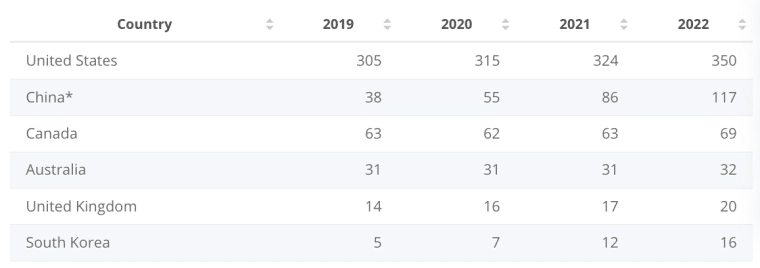
What’s the Meaning of the Lululemon Logo?
The history of Lululemon and its iconic logo is a visual narrative that mirrors the brand’s evolution. The logo, a combination of a stylized “A” within a circular shape, represents the original concept of the name, “Athletically Hip”. This integration was a collaborative effort between Wilson and graphic artist Stephen Bennett.
The Lululemon logo can also be viewed as an artistic Omega (Ω), drawing inspiration from the Greek alphabet where Omega signifies completeness.
Though not officially confirmed by the company, this representation underscores Lululemon’s focus on the journey over the destination, reflecting a commitment to continual well-being and self-discovery.

In the logo selection process, Chip presented 20 diverse design possibilities to the Lululemon focus groups. Chip Wilson has emphasized Lululemon’s logo alignment with the brand’s focus on the female form and functionality.
I realized that the shape of our logo provided a perfect contour to enhance the natural shape of a woman’s body.

Throughout the 25+ year history of Lululemon, the company has upheld its original logo, underscoring its importance in establishing and maintaining brand recognition and customer allegiance.
The Inspiration Behind Lululemon’s Name
Understanding the history of Lululemon wouldn’t be complete without delving into the origin of its name.
Founder Chip Wilson explored various name options, inspired by the popularity of the letter “L” in Western-sounding names in Japan. Playing with alliterations, the name Lululemon surfaced unexpectedly during his brainstorming sessions.

Wilson added the descriptor “athletica”, aiming for a Euro-West Coast blend that distinguished the brand from typical male-focused athletic stores.
@chipwilson.official Replying to @lifeofellefit Leave me a comment if you’d like part three. #chipwilson #lululemonfounder #lulufounder
In 2005, reports suggested Chip Wilson mocked how Japanese people pronounce the letter L, but Lululemon denied these claims. According to ABC News, Wilson remarked, “It’s funny to watch them try and say it,” as reported by Canada’s National Post Business Magazine.
Along with racist comments from the former founder, Lululemon has been embroiled in other controversies, that we cover in detail here.
The Future of Lululemon
In December 2023, Lululemon Athletica was valued at $39.06 billion, and looking ahead, the Vancouver-based company is taking a bold course for its future. The company’s 2026 growth strategy aims to double men’s apparel sales, return double digital revenues, and quadruple international earnings. It aims for a 15% CAGR in total net revenue under its Power of Three ×2 growth plan from 2021 to 2026.

Concurrently, Lululemon has demonstrated a strong commitment to sustainability, showcasing initiatives like the Align Legging Dupe Swap event in May 2023 and engaging in design efforts to ensure that all its products are made from sustainable materials by 2030.
Tracing the captivating history of Lululemon reveals that innovation, strategic decisions, and a dedication to quality were integral to its success. The journey unfolded with pivotal milestones, illustrating how Lululemon not only embraced but also redefined industry standards. Reflecting on the history of Lululemon makes it clear that its legacy extends beyond athletic apparel to shaping a cultural movement toward wellness and mindful living.
